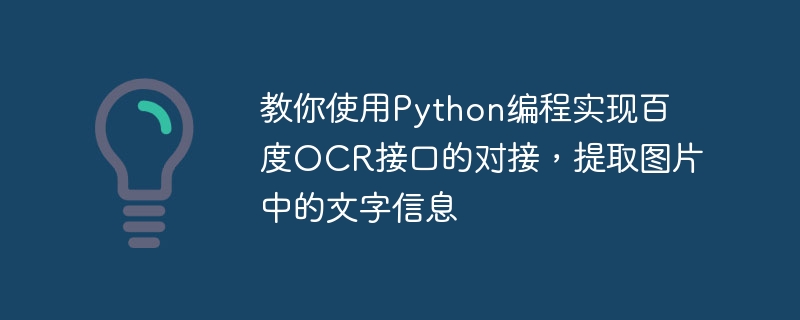

Teach you to use Python programming to implement the docking of Baidu OCR interface and extract the text information in the picture
Introduction:
With the rapid development of artificial intelligence, text Huge progress has also been made in the field of identification. Baidu OCR (Optical Character Recognition, optical character recognition) is an important technology that can convert text information in pictures into editable text, bringing great convenience to people. This article will teach you how to use Python programming to implement the docking of Baidu OCR interface and extract text information from pictures.
Install dependent libraries
In Python, we can use the baidu-aip library to call the Baidu OCR interface. You can use the following command to install the library:
pip install baidu-aip
At the same time, you also need to install the Pillow library for processing images:
pip install Pillow
Write the code
First , we need to import the required libraries:
from aip import AipOcr from PIL import Image
Then, we need to set the API key and secret key of Baidu OCR:
APP_ID = 'your_app_id' API_KEY = 'your_api_key' SECRET_KEY = 'your_secret_key'
Next, we need to define a function to implement the image recognition function :
def recognize_image(image_path):
# 初始化AipOcr对象
client = AipOcr(APP_ID, API_KEY, SECRET_KEY)
# 读取图片
with Image.open(image_path) as image:
# 将图片转换为Base64编码
image_data = image.tobytes()
# 调用百度OCR接口,识别图片中的文字
result = client.basicGeneral(image_data)
# 获取识别结果
if 'words_result' in result:
words = [item['words'] for item in result['words_result']]
return words
else:
return NoneFinally, we can call this function to extract the text information in the picture:
if __name__ == '__main__':
image_path = 'your_image_path.jpg'
recognized_words = recognize_image(image_path)
if recognized_words:
for word in recognized_words:
print(word)
else:
print('识别失败')Summary:
Through the guidance of this article, we have learned how to use Python programming to implement the docking of Baidu OCR interface and extract text information from pictures. The application of Baidu OCR technology can not only improve the accuracy and efficiency of text recognition, but also provide more possibilities for the processing and analysis of text information. I hope readers can use the guidance of this article to better apply Baidu OCR technology and achieve more interesting and useful functions.
The above is the detailed content of Teach you how to use Python programming to connect to Baidu OCR interface and extract text information from pictures. For more information, please follow other related articles on the PHP Chinese website!




